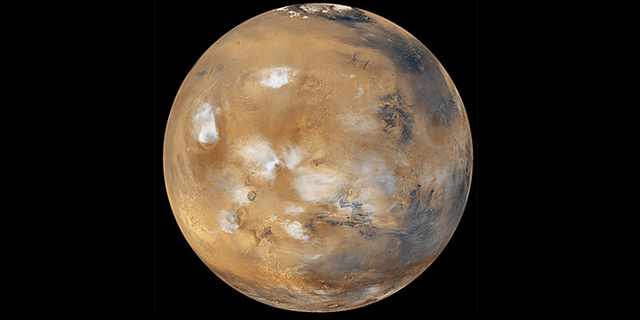
Welcome to Mars
This week the number of operational spacecraft in orbit around our rusty neighbour jumped from three to five. NASA’s MAVEN and ISRO’s Mangalyaan both reached the red planet this week, joining NASA’s Mars Odyssey, NASA’s MRO, and ESA’s Mars Express.
MAVEN, the Mars Atmosphere and Volatile Evolution mission, reached the planet on Monday. As you’re probably aware, Mars used to be a lot wetter than it is today, leaving scientists to ask “where did all the water go?” The chief possibilities seem to be “up” and “down,” and MAVEN is designed to test the former. Launched in November of last year, NASA’s latest probe is designed to skirt the planet’s thin atmosphere and figure out whether Mars lost its water to space. It will do this by measuring the effects of the solar wind on the atmosphere, as well as measuring the current escape rate of neutral gases and the ratios of stable isotopes in the atmosphere. Between MAVEN and Curiosity’s arrival at Mount Sharp last week, we may well be able to answer the riddle of Mars’s water.
Mangalyaan, Sanskrit for “Mars craft” (मंगल mangala “Mars” + यान yāna “craft, vehicle”), is the first mission to Mars by the Indian Space Research Organization. When it arrived on Wednesday it marked the country’s entry into a very select club: only three space agencies have ever made it this far (NASA, ESA, and Roscosmos) and none of them did it on their first try. It’s a seriously formidable achievement and everyone that took part in it should be incredibly proud. The Mars Orbiter Mission doesn’t come with a lot of bells and whistles — it’s mostly being used as a demonstration mission — but it will be adding to the data coming from MAVEN regarding the composition of the atmosphere and loss to space as its mission progresses over the next six to ten months.
Shellshock
If you’re still a Windows user after all the bizarre missteps they’ve made in the past 18 months (not to mention the awful commercials — anyone else remember “scroogled”?) then for once you can skip this piece of security-related news. Turns out for anyone using a unix or linux-based system, there’s a bit of a bug. “Bash” (Bourne-Again SHell) is a text-based command prompt used since the 1980s in a lot of computer systems, from OSX to Linux and beyond. The bug has to do with the way that bash interprets text put in as an “environment variable,” that allows certain commands to be hidden in strings of code and executed when they shouldn’t be. As someone who uses bash a lot might be able to tell you, the command ‘() { :;}; echo “vulnerable”‘ shouldn’t be run — but the fact that it’s typing “vulnerable” when you hit enter means that, yep, it’s running. And this isn’t just a problem for folks who run things in terminal, as this great Vox article explains:
For now there’s not a lot you can do, save turning off your computers and waiting it out. Linux and Mac users should keep their eyes open for new security updates, as there are teams of people scrambling all over the world both to fix the bug as well as to exploit it.

Paypal and Bitcoin
In news that’s sure to make fans of the cryptocurrency raise their eyebrows, this week Paypal announced it has partnered with three major Bitcoin processing companies (Coinbase, BitPay, and GoCoin) to allow its vendors to accept the currency with what they probably consider more ease. The price of Bitcoin jumped around USD 50.00 mid-week in response to the news, but has since fallen back to its week starting price of USD 400.00. It doesn’t look as though it will be making much difference to the way PayPal operates, but it might spread the fledgling currency’s adoption, which has seen growth at an average of about 6% per month on the vendor size for the past six months. If that rate of adoption holds (a pretty big if, I suppose), the number of merchants accepting Bitcoin could reach 100,000 in the next 24-48 months. Guess we’ll wait and see.
CCtCap Fallout
In what’s become an industry standard move, Sierra Nevada Corp. announced this week that it would be filing a protest with the US GAO (Government Accountability Office) over the awarding of the CCtCap contracts last week to SpaceX and Boeing. By all expectations, the complaint will likely point out that they asked for less money than Boeing and may argue that they have progressed further toward construction than Boeing (though the latter will be harder to prove). Regardless of their intentions for the Dream Chaser, SNC has been forced to lay off roughly 100 people in the wake of the contract decision. The GAO is required to respond to the complaint within 100 days. For the sake of the Dream Chaser, let’s all hope they get a contract with JAXA or ESA in the meantime.
Scanning for Autism
New research out of the Albert Einstein College of Medicine at Yeshiva University suggests that in the future we may be able to diagnose autism spectrum disorders in a more objective, data-driven way. At present, ASD diagnoses rely largely on observational assessments of patients, but that may change soon. The researchers have been studying the way different brains look with an EEG sensor cap while patients are exposed to specific visual or audio stimuli, and they believe they’ve found a correlation that could in the future prove diagnostic. The study was limited to only 43 participants, so it’s still early days yet, but if it holds up under further scrutiny it could mean a sea-change in the way we diagnose people on the autism spectrum.
New Lows
Scientists at NASA’s Jet Propulsion Laboratory (JPL) announced this week that their Cold Atom Laboratory (due to make its ISS debut in 2016) has reached a major milestone: they’ve succeeded in creating a Bose-Einstein Condensate. The temperature they were able to reach is so close to absolute zero (0° Kelvin) that it’s almost impossible to wrap your head around it: 200 nanoKelvin, or 200-billionths of a degree above absolute zero. Just to give you an idea of the nanoscale, that means if you decided that the distance from Earth to the Moon were a single meter (it’s currently roughly 384,400,000 meters from us), a nanometre would still only be 38cm, just a little over a foot. Twenty nanoKelvins above zero is so close to zero that it’s a major technological feat just to be able to tell the difference between it and zero. Now the JPL has made something that can get down to those temperatures on the ISS. I can’t wait to see what they do with it.
Best of the Rest
I saw a lot of interesting things on the net this week. Here are some of them. SpaceX broke ground on its new Texas launch facility; NASA made a gorgeous origami fold-out solar array; researchers have found out how to make yeast age less (and maybe someday us, too); Jeremy Geddes made some gorgeous surreal paintings featuring cosmonauts in strange places; Gizmodo did a roundup of ten strange things NASA’s been up to of late; an engineer has designed a better ice cream scoop (for real); and, in news that is bound to surprise and astound, the new designs for the USB call for it to be a whole lot more “universal” — it’ll output DisplayPort and HDMI, carry 100watts of power, and be REVERSIBLE. The future is friendly.
That’s all for now. Have a great week.

